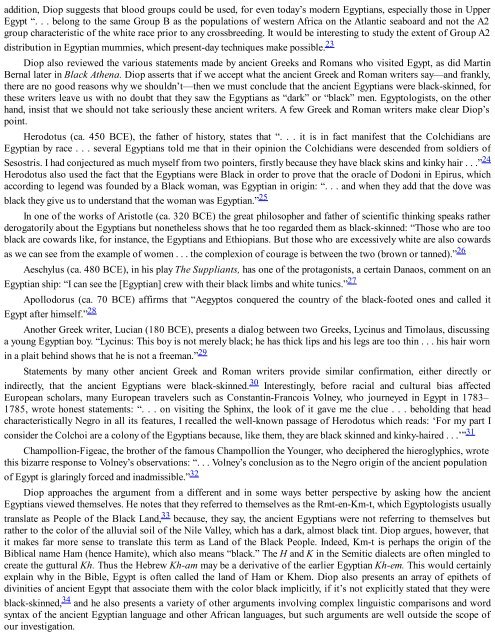Black Genesis: The Prehistoric Origins of Ancient Egypt
Black Genesis: The Prehistoric Origins of Ancient Egypt
Black Genesis: The Prehistoric Origins of Ancient Egypt
Create successful ePaper yourself
Turn your PDF publications into a flip-book with our unique Google optimized e-Paper software.
addition, Diop suggests that blood groups could be used, for even today’s modern <strong>Egypt</strong>ians, especially those in Upper<br />
<strong>Egypt</strong> “. . . belong to the same Group B as the populations <strong>of</strong> western Africa on the Atlantic seaboard and not the A2<br />
group characteristic <strong>of</strong> the white race prior to any crossbreeding. It would be interesting to study the extent <strong>of</strong> Group A2<br />
distribution in <strong>Egypt</strong>ian mummies, which present-day techniques make possible. 23<br />
Diop also reviewed the various statements made by ancient Greeks and Romans who visited <strong>Egypt</strong>, as did Martin<br />
Bernal later in <strong>Black</strong> Athena. Diop asserts that if we accept what the ancient Greek and Roman writers say—and frankly,<br />
there are no good reasons why we shouldn’t—then we must conclude that the ancient <strong>Egypt</strong>ians were black-skinned, for<br />
these writers leave us with no doubt that they saw the <strong>Egypt</strong>ians as “dark” or “black” men. <strong>Egypt</strong>ologists, on the other<br />
hand, insist that we should not take seriously these ancient writers. A few Greek and Roman writers make clear Diop’s<br />
point.<br />
Herodotus (ca. 450 BCE), the father <strong>of</strong> history, states that “. . . it is in fact manifest that the Colchidians are<br />
<strong>Egypt</strong>ian by race . . . several <strong>Egypt</strong>ians told me that in their opinion the Colchidians were descended from soldiers <strong>of</strong><br />
Sesostris. I had conjectured as much myself from two pointers, firstly because they have black skins and kinky hair . . .” 24<br />
Herodotus also used the fact that the <strong>Egypt</strong>ians were <strong>Black</strong> in order to prove that the oracle <strong>of</strong> Dodoni in Epirus, which<br />
according to legend was founded by a <strong>Black</strong> woman, was <strong>Egypt</strong>ian in origin: “. . . and when they add that the dove was<br />
black they give us to understand that the woman was <strong>Egypt</strong>ian.” 25<br />
In one <strong>of</strong> the works <strong>of</strong> Aristotle (ca. 320 BCE) the great philosopher and father <strong>of</strong> scientific thinking speaks rather<br />
derogatorily about the <strong>Egypt</strong>ians but nonetheless shows that he too regarded them as black-skinned: “Those who are too<br />
black are cowards like, for instance, the <strong>Egypt</strong>ians and Ethiopians. But those who are excessively white are also cowards<br />
as we can see from the example <strong>of</strong> women . . . the complexion <strong>of</strong> courage is between the two (brown or tanned).” 26<br />
Aeschylus (ca. 480 BCE), in his play <strong>The</strong> Suppliants, has one <strong>of</strong> the protagonists, a certain Danaos, comment on an<br />
<strong>Egypt</strong>ian ship: “I can see the [<strong>Egypt</strong>ian] crew with their black limbs and white tunics.” 27<br />
Apollodorus (ca. 70 BCE) affirms that “Aegyptos conquered the country <strong>of</strong> the black-footed ones and called it<br />
<strong>Egypt</strong> after himself.” 28<br />
Another Greek writer, Lucian (180 BCE), presents a dialog between two Greeks, Lycinus and Timolaus, discussing<br />
a young <strong>Egypt</strong>ian boy. “Lycinus: This boy is not merely black; he has thick lips and his legs are too thin . . . his hair worn<br />
in a plait behind shows that he is not a freeman.” 29<br />
Statements by many other ancient Greek and Roman writers provide similar confirmation, either directly or<br />
indirectly, that the ancient <strong>Egypt</strong>ians were black-skinned. 30 Interestingly, before racial and cultural bias affected<br />
European scholars, many European travelers such as Constantin-Francois Volney, who journeyed in <strong>Egypt</strong> in 1783–<br />
1785, wrote honest statements: “. . . on visiting the Sphinx, the look <strong>of</strong> it gave me the clue . . . beholding that head<br />
characteristically Negro in all its features, I recalled the well-known passage <strong>of</strong> Herodotus which reads: ‘For my part I<br />
consider the Colchoi are a colony <strong>of</strong> the <strong>Egypt</strong>ians because, like them, they are black skinned and kinky-haired . . .’” 31<br />
Champollion-Figeac, the brother <strong>of</strong> the famous Champollion the Younger, who deciphered the hieroglyphics, wrote<br />
this bizarre response to Volney’s observations: “. . . Volney’s conclusion as to the Negro origin <strong>of</strong> the ancient population<br />
<strong>of</strong> <strong>Egypt</strong> is glaringly forced and inadmissible.” 32<br />
Diop approaches the argument from a different and in some ways better perspective by asking how the ancient<br />
<strong>Egypt</strong>ians viewed themselves. He notes that they referred to themselves as the Rmt-en-Km-t, which <strong>Egypt</strong>ologists usually<br />
translate as People <strong>of</strong> the <strong>Black</strong> Land, 33 because, they say, the ancient <strong>Egypt</strong>ians were not referring to themselves but<br />
rather to the color <strong>of</strong> the alluvial soil <strong>of</strong> the Nile Valley, which has a dark, almost black tint. Diop argues, however, that<br />
it makes far more sense to translate this term as Land <strong>of</strong> the <strong>Black</strong> People. Indeed, Km-t is perhaps the origin <strong>of</strong> the<br />
Biblical name Ham (hence Hamite), which also means “black.” <strong>The</strong> H and K in the Semitic dialects are <strong>of</strong>ten mingled to<br />
create the guttural Kh. Thus the Hebrew Kh-am may be a derivative <strong>of</strong> the earlier <strong>Egypt</strong>ian Kh-em. This would certainly<br />
explain why in the Bible, <strong>Egypt</strong> is <strong>of</strong>ten called the land <strong>of</strong> Ham or Khem. Diop also presents an array <strong>of</strong> epithets <strong>of</strong><br />
divinities <strong>of</strong> ancient <strong>Egypt</strong> that associate them with the color black implicitly, if it’s not explicitly stated that they were<br />
black-skinned, 34 and he also presents a variety <strong>of</strong> other arguments involving complex linguistic comparisons and word<br />
syntax <strong>of</strong> the ancient <strong>Egypt</strong>ian language and other African languages, but such arguments are well outside the scope <strong>of</strong><br />
our investigation.


